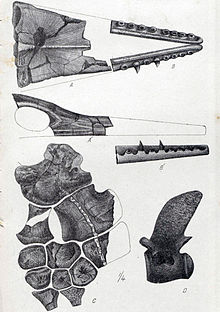Taniwhasaurus
aus Wikipedia, der freien Enzyklopädie
| Taniwhasaurus | ||||||||||||
|---|---|---|---|---|---|---|---|---|---|---|---|---|

Taniwhasaurus in einer Lebendrekonstruktion | ||||||||||||
| Zeitliches Auftreten | ||||||||||||
| Oberkreide (oberes Santonium bis Maastrichtium) | ||||||||||||
| 85,2 bis 66 Mio. Jahre | ||||||||||||
| Fundorte | ||||||||||||
| Systematik | ||||||||||||
| ||||||||||||
| Wissenschaftlicher Name | ||||||||||||
| Taniwhasaurus | ||||||||||||
| Hector, 1874 | ||||||||||||
Taniwhasaurus (Maori Taniwha, ein drachenartiges Wasserungeheuer; Gr. sauros = Echse, Syn.: Tylosaurus haumuriensis) ist eine Gattung der Mosasaurier aus der Zeit der Oberkreide. Der einen halben Meter lange Schädel des Typusexemplars wurde bei Kaikoura auf der Südinsel Neuseelands gefunden und als Taniwhasaurus oweni beschrieben. Das gesamte Tier war wahrscheinlich sechs Meter lang. Der Schädel des vorher als Tylosaurus haumuriensis bezeichneten Fossils ist 1,1 Meter lang und das Tier erreichte wahrscheinlich eine Länge von zwölf Metern.[1]
Merkmale
[Bearbeiten | Quelltext bearbeiten]
Taniwhasaurus war ein großer Tylosaurinae, der am Ende des Unterkiefers den für die Unterfamilie typischen zahnlosen Rammsporn hatte. Die Zähne waren seitlich abgeflacht, ungesägt und hatten vorne und hinten scharfe Ränder. Die Gaumenzähne waren sehr klein. Taniwhasaurus war nahe mit Hainosaurus verwandt.[1][2]
Arten
[Bearbeiten | Quelltext bearbeiten]Bisher wurden drei Arten beschrieben: T. oweni, aus Neuseeland, T. antarcticus aus der Antarktis[3] und T. mikasaensis aus Japan.[4] Taniwhasaurus ist damit der einzige bekannte Tylosaurinae, der auch auf der Südhalbkugel der Erde lebte[2].
Literatur
[Bearbeiten | Quelltext bearbeiten]- Richard Ellis: Sea Dragons. Predators of the Prehistoric Oceans. University Press of Kansas, Lawrence KS 2003, ISBN 0-7006-1269-6.
Weblinks
[Bearbeiten | Quelltext bearbeiten]Einzelnachweise
[Bearbeiten | Quelltext bearbeiten]- ↑ a b Ben Creisler: Mosasauridae Translation and Pronunciation Guide Taniwhasaurus ( des vom 3. April 2010 im Internet Archive) Info: Der Archivlink wurde automatisch eingesetzt und noch nicht geprüft. Bitte prüfe Original- und Archivlink gemäß Anleitung und entferne dann diesen Hinweis.
- ↑ a b Nathalie Bardet, Xabier Pereda Suberbiola, José C. Corral: A Tylosaurine Mosasauridae (Squamata) from the Late Cretaceous of the Basque-Cantabrian Region. In: Estudios Geológicos. Bd. 62, Nr. 1, 2006, ISSN 0367-0449, S. 213–218, doi:10.3989/egeol.0662121, Digitalisat (PDF; 401,08 KB).
- ↑ Marta Fernandez, James E. Martin: Description and phylogenetic relationships of Taniwhasaurus antarcticus (Mosasauridae, Tylosaurinae) from the upper Campanian (Cretaceous) of Antarctica. In: Cretaceous Research. Bd. 30, Nr. 3, 2009, ISSN 0195-6671, S. 717–726, doi:10.1016/j.cretres.2008.12.012.
- ↑ A new species of Taniwhasaurus (Mosasauridae, Tylosaurinae) from the Upper Santonian-LowerCampanian (Upper Cretaceous) of Hokkaido, Japan. 2008, Abstract online.
Text is available under the CC BY-SA 4.0 license; additional terms may apply.
Images, videos and audio are available under their respective licenses.
